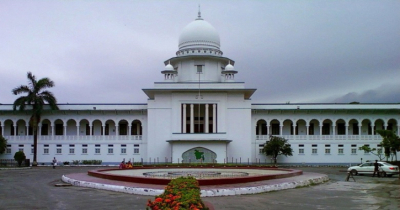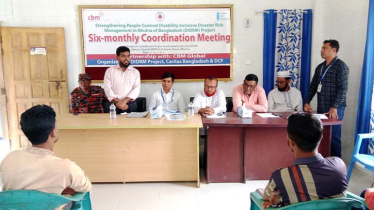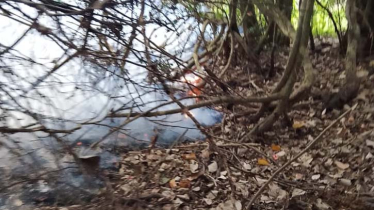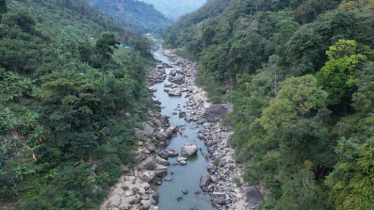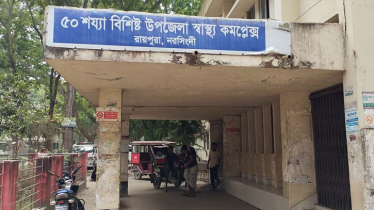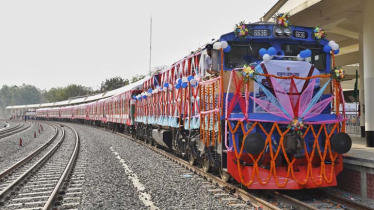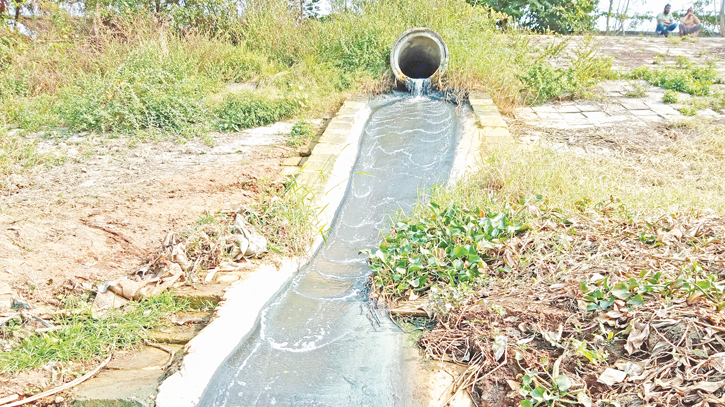
Photo : Messenger
The unregulated disposal of tannery waste into the Dhaleswari River is contributing to an environmental crisis. The detrimental impact of this pollution extends beyond the river's ecosystem, putting at risk the diverse flora and fauna that rely on its waters. Additionally, the contamination poses a direct threat to the agricultural lands adjacent to the river, further exacerbating the potential for ecological and economic damage.
Environmentalists have highlighted a concerning decline in the levels of dissolved oxygen in the waters of the Kaliganga and Ghazikhali rivers, as well as the Dhaleswari River. This alarming situation is primarily attributed to the discharge of waste from factories in the Savar tannery estate and its surrounding areas.
Observations at Hemayetpur Tannery Industrial City reveal an absence of a proper treatment system for the chemical liquid waste generated by the tanneries, leading to unregulated dumping. The area designated for waste disposal lacks adequate infrastructure, allowing the waste to directly flow into the Dhaleswari River, particularly during periods of minimal rainfall. In addition to the chemical concerns, solid waste management faces various challenges.
Observations at Hemayetpur Tannery Industrial City reveal an absence of a proper treatment system for the chemical liquid waste generated by the tanneries, leading to unregulated dumping. The area designated for waste disposal lacks adequate infrastructure, allowing the waste to directly flow into the Dhaleswari River, particularly during periods of minimal rainfall. In addition to the chemical concerns, solid waste management faces various challenges.
Notably, the Common Effluent Treatment Plant (CETP) at BSCIC Tannery Industrial Estate is grappling with insufficient capacity to effectively manage both liquid and solid waste.
Visibly, multiple large pipes have been installed to discharge the liquid waste from the tanneries. Unfortunately, these pipes serve as conduits for the direct release of the tannery's black liquid waste into the nearby Dhaleswari River. The liquid waste, characterised by its dark color, contains a variety of chemicals, posing a significant environmental concern.
Reports indicate that the mixture of tannery waste and chemical liquids has been observed upstream in the Dhaleswari River, passing through Shingair Upazila in Manikganj district town to Ghior Upazila. On the downstream side, as the water from the Dhaleswari River converges with the Kaliganga River, the spread of tannery wastes and chemical liquids becomes evident over extensive areas. This contamination poses a significant environmental challenge, affecting the water quality and potentially impacting ecosystems along the riverbanks.
Sources familiar with the issue said that in an attempt to cut costs, the Central Effluent Treatment Plant (CETP) in the tannery is frequently shut down. Consequently, the liquid waste is directly dumped into the river. Even when CETP is operational, the water discharged from it into the river exceeds the acceptable levels of harmful chemicals. This not only poses a threat to the biodiversity of the river but also jeopardises the livelihoods of at least five lakh people who rely on agriculture in the towns situated along the riverbanks.
The environmental impact extends beyond river pollution, as the tannery industry emits poisonous gases and a pervasive stench that poses health risks to the human being. This issue is prevalent over an approximately three-kilometer area encompassing Dhalla and Jamirta Unions in Manikganj's Shingair. The detrimental effects of these emissions are evident in the local population, leading to various health problems, including respiratory issues and skin diseases among the affected residents.
On-site observations reveal that the tannery wastes along the banks of the Dhaleswari River in the Harindhara area, bordering Savar and Keraniganj upazilas in Dhaka district, have significantly altered the water color of the river, turning it black, and unleashed a pervasive stench. Additionally, waste dumping from various industries and the Savar municipality is directly entering the river through the Karnapara canal in Savar. This waste is further spreading through the Dhaleswari River, eventually reaching the Bangshi River approximately two and a half kilometers away.
The detrimental effects of pollution are evident in the significant decline of various aquatic animals, including fish, in both the Dhaleswari and Bangshi Rivers. Moreover, the stench and pollution have rendered water unusable for various household activities in the riverside towns. The affected communities are experiencing disruptions in their daily chores due to the compromised water quality.
The adverse impact extends to the people living along the riverbanks, who are now unable to bathe in the contaminated water. Bathing in the river water has led to the emergence of various skin diseases among the residents.
Habibur Rahman, a farmer residing along the riverbanks, expressed the distressing situation, noting that the river water has become so foul-smelling that it is challenging to stay in the vicinity. Previously, he used the river water for cultivating various crops, including IRRI-Boro rice and vegetables. However, due to the impact of tannery wastes from Hemayetpur and certain factories in Savar, agricultural activities on the land have been halted. The pollution has not only disrupted the environment but has also adversely affected the livelihoods of local farmers who rely on the river for their agricultural needs.
Arshed Ali, a resident of Dakshin Dhalla village, voiced concerns about the deteriorating state of the river. He highlighted that the toxic effluents discharged by the tannery industry have rendered the river water unsuitable for human consumption. The pollution from tannery waste is significantly impacting the river's environment, portraying a dire and challenging situation.
Dhalla Union Parishad Chairman, Mohammad Zahidul Islam Bhuiyan, shared with The Daily Messenger that a significant portion of the population residing along the riverbanks is dependent on agriculture. However, the pollution caused by waste dumping into the river has created a substantial strain on agriculture. The contamination of river water and the resultant environmental degradation have led to a crisis in crop production in the area.
Abu Md Enayet Ullah, Deputy Director of Manikganj District Agricultural Extension Directorate, told The Daily Messenger that in the riverbanks of Dhaleswari, various crops, including vegetables, were traditionally grown. However, due to the pollution caused by waste from factories and tanneries, farmers have ceased using Dhaleswari river water for agriculture. Instead, they have shifted to cultivating crops through deep tube wells.
Ashikur Rahman, the owner of Glorious Trade International, pointed out that BSCIC lacks the capacity to effectively manage waste. Tannery owners are responsible for storing the waste in their own tanks, but they face challenges in implementing the necessary Environmental Treatment Plant (ETP) management. The solution requires the construction of large tanks, incurring significant expenses. Additionally, the waste stored for dumping is left exposed, and during rainfall, it is directly discharged into the river.
Tariq Jahangir, a leather trader in Savar, highlighted the intricate leather processing procedure, involving the use of approximately 92 types of chemicals. Despite utilising around 45 of these chemicals, the waste generated during the leather processing poses significant harm when it mixes with water.
Mehdi Hasan, a technologist at Anwar Tannery, provided insights into the scale of tannery waste, indicating that Anwar Tannery disposes of two trolleys of waste daily. Some tanneries operate with two drums each, and each trolley has a capacity of two tons of liquid waste. In the BSCIC area, which houses 120 tanneries with 150 drums, the cumulative waste generation amounts to 600 tons per day.
মেসেঞ্জার/দিশা

